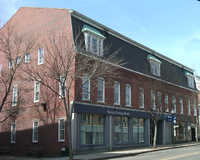
Shops in the Exchange Block, Biddeford, ca. 1915
McArthur Public Library
Throughout Maine during these years most of the large manufactures either moved to the South or where floated along temporarily by business interests in the state. The companies worked hard to innovate and improve themselves, but the post-war economies and business environment were setting them on a path of which there was not return. The expansion and conglomeration of all of the major manufactures in Biddeford and Saco: the Saco-Lowell Shops, York (Bates) Manufacturing, and Pepperell (WestPoint) Manufacturing, would follow a similar pattern.
Expansion, innovation and improvements followed by a period of profitability, then the decision by Boards and owners out-of-state to sell off the Biddeford and Saco "divisions" or move them down South to the textile production centers of Georgia and Alabama, where the help was cheaper and the raw materials were grown next door. By 1960 both York Manufacturing and Saco-Lowell Shops were closed.

Pavilion Congregational Church, Biddeford, 1870
McArthur Public Library
There were some large employers left in the wake, but not big enough to fill the void left by the closures of York and Saco-Lowell. A separate division of the Saco-Lowell Shops known as the Edwards Plant, which produced automotive parts and weapons, was acquired by Maremont Corporation and continues to build weapons under the name General Dynamics. Pepperell's saving grace was the invention and production of the Vellux blanket by Francis Spencer, and a very small portion of the mills continued operation making a variety of blankets. The division finally closed in entirety in 2009, a final end to over 150 years of production.
The demise of these large scale manufacturers meant that for quite some time things appeared bleak for the Biddeford area. "Brain-drain", or the emigration of young, educated professionals to better paying areas in New England and elsewhere was another blow to the local & state economies as early as the 1940's, and certainly through the 1980's and 1990's. Wages in Biddeford and throughout Maine were lower, people who would have made a good living in manufacturing were underemployed and working poor, and those who were able to get an education had to leave the area to get ahead.

 Exchange Block, 2010.
Exchange Block, 2010.
 McArthur Library, 2010. Photograph by Devin Ouellette, Biddeford High School.
McArthur Library, 2010. Photograph by Devin Ouellette, Biddeford High School.